Ashwin Prabhu and Akhila Seshadri
The modern schooling paradigm, as we recognize it today, emerged less than a couple of centuries ago, from a need in society to create a safe, efficient, and affordable space where children could be enrolled to learn basic literacy and numeracy while the parents tended to their livelihoods. This view of education has yielded several generations of citizens, who in turn have framed public policy which has ended up defining and creating newer roles and purposes for schools. Over the years, agendas like “nation-building”, “character-development”, “creativity and innovation” have all been incorporated into the schooling project. Thus, it is quite apparent that schools and society inform and shape each other in equal measure. Put simply, there needs to be a recognition that schools are a part of society and not apart from it.
The current moment, in at least urban, private education, is one where “individual attention and care” has taken precedence over most other educational goals. In the pursuit of building out these individual capabilities and enabling a path for personal excellence and success, many city schools have become insular spaces, quite disconnected from the immediate realities of their physical locations. Of the many casualties of such an approach to education, two particularly stand out. The first being, that in this, children tend to view themselves as unique products of just their own homes and schools, and do not value the fact that there are quite a few, larger factors which have allowed for their own development and functioning in society – an often invisible worker-class which provides several essential housekeeping and maintenance services thus freeing up the privileged to single-mindedly pursue their ‘dreams’, a profusion of public utilities and services provided by the state which often receive flak but little recognition, a general, choiceless acceptance of sharp social and economic disparities by the marginalized, and so on. The second loss is that of a sense of relationship which the child feels with externalities outside of the walls of home and school. Relationships can exist only where there is engagement. And schools can be faulted for not creating sufficient educational contexts which allow for this engagement between the individual and the collective.
Enabling the child to engage with not just the teacher or the classmate, but also the metaphorical “neighbour”, and in the process hopefully nurture a sense of relationship, is an integral part of the educational endeavour at the Krishnamurti schools and each of these schools has explored this in different ways. The School KFI, a day school in urban Chennai, has had a long history of using ‘Area Studies’ as a pedagogical tool for children to learn about their neighbourhoods and communities in a first-hand manner. Since the early 1990s, children along with their teachers have worked to systematically study several city neighbourhoods in their school’s vicinity like Mylapore, Adyar, and Thiruvanmiyur. In 2018, when the school had to relocate from its home of 40 years in Adyar to a new, peri-urban location in Thazhambur, 25 kms away, the teachers and children were met with a new situation – being in a physical space which was new and unfamiliar, but also in an emotional space characterized by a feeling of uprootedness and loss. This provided a very specific context where there was not only a need for the school to put down roots in a new home, but also to find ways in which its teachers and students could begin to feel a sense of relatedness to their physical location. One way in which the school responded was to get the students of class 8 to do a detailed area study of Thazhambur, the new neighbourhood into which it was settling.
Over the years, a clear framework for these area studies has emerged at The School KFI, Chennai:
• Every child in the class participates in the Area Study project; this in turn means that a group of 4-5 teachers anchors the study for the children.
• The study is conducted over several days; in some cases, even over a few weeks. Class timetables have to be redrawn and regular school routines may have to be given up in the interest of the study.
• The first step for the teacher is to outline and fix a certain geographical scope for the study, say within a 2 to 3 km radius of a focal point. Within that earmarked area, the students pursue a multi-disciplinary exploration.
• Teachers organize the class into small groups of 6-8 children; children get opportunities to work both individually and in the small groups.
• The study itself involves a significant amount of walking, mapping, conversations with people, descriptive writing, and sketching.
• Each day of the study ends with a ‘Circle Time’ which enables children to share what they have seen, heard, and learned and reflect on it, while also setting aside time to plan for the next day of the study.
• And finally, when the study is complete, the children share their learning with the larger school community. This could happen in a variety of ways – assemblies, chart displays, posters and booklets, open houses, or school melas.
• All of this requires the full support of the school head who must actively champion this style of learning.
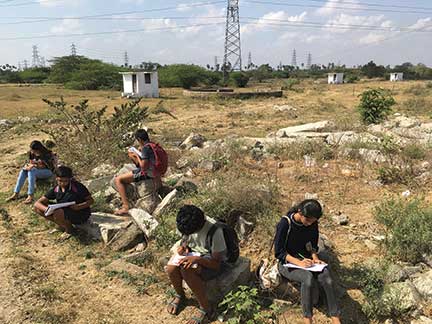
Teachers will do well to keep in mind a few pointers while planning the study. For one, it is important to form small groups such that each has children with complementary abilities. For example, a group could have at least one child who can speak the local language confidently, one who can read the language script well, someone who is good at sketching and art, and another who can jot down neat and descriptive notes. This allows for the small group to be independent while enabling children to work well with one another. Secondly, the teachers should ensure that there is an orientation and preparatory phase prior to the project where students are taught the core skills required for the project – mapping, interview techniques, note-taking and how to organize information, how to do surveys and tabulation of critical data, and fact-checking.
The Thazhambur Area Study was conducted over five days in February of 2019. The class of 27 children was organized into five groups of 5-6 children, each anchored by a teacher. It was decided that the study would be limited to a radius of two kms from the school in each of the four cardinal directions – north, south, east, and west. One group each was assigned to north, south and west, while two groups were assigned to the east since the route was congested and had many more things to observe and study in comparison to the other three directions. Each group was given a standard checklist of things to do –
• Map the walking route while noting down the location of important public institutions, natural water bodies, places of worship, civic amenities like bus-stops, parks, post-offices, public water-tanks, police-stations, schools, and the like.
• Identify individual role-bearers like secretaries of resident associations, panchayat presidents or ward councillors, proprietors of key merchant establishments, priests in places of worship whom they would like to interview and learn from.
• Make sketches of anything that caught the eye – landscapes, plants, trees, landmark buildings, signages, etc.
• Conduct public surveys on issues they would like to understand better along their routes. For example, traffic volume, how long had people been living in the neighbourhood, garbage disposal mechanisms.
• Note down new and unfamiliar words or acronyms they come across which they would like to bring back to school and research.
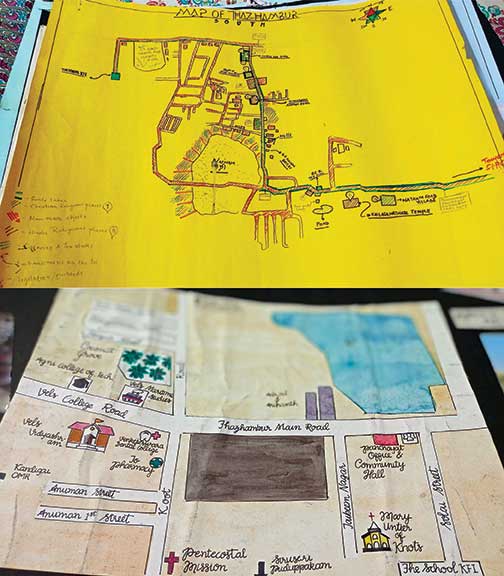
In terms of daily routine during the project, the children would head out each day on their study after breakfast in school and return around lunch time – a duration of around 3-4 hours. After lunch in school, the children would meet in their small groups, consolidate and summarize their documentation, before joining the full-class Circle Time discussion anchored by the teachers.
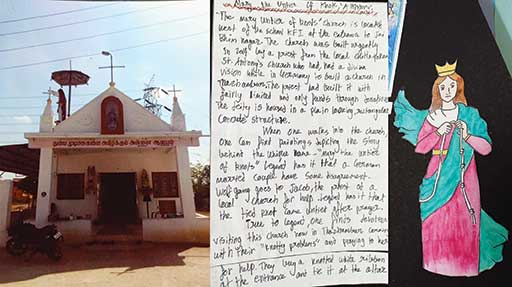
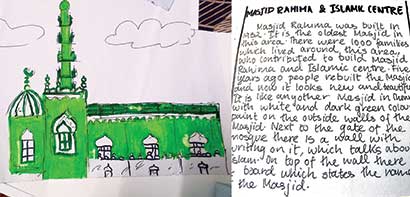
One of the most interesting aspects of an Area Study is that children learn from direct observation and interactions with local people. Often, this throws up surprising insights – for example, while wondering about the large number of tanker lorries in Thazhambur, children found out by speaking to residents that many of them had leased out their vacant plots of land to water supply operators who had dug borewells and were extracting groundwater to be supplied to urban Chennai through lorries – a lucrative business enterprise!
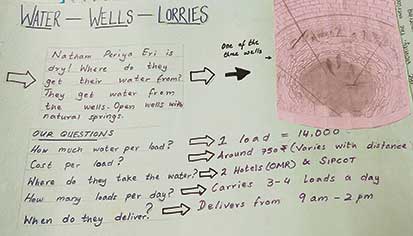
On another occasion, one group of children while interacting with migrant labourers from outside the state working on a construction site in Thazhambur learned that they felt a deep sense of uprootedness having moved away from home for work, and the children found themselves comforting the workers! One of the groups which walked to the local eri (traditional irrigation tanks found in Tamil Nadu), found that sections of the catchment area of the eri had been encroached by a large upscale, residential community.
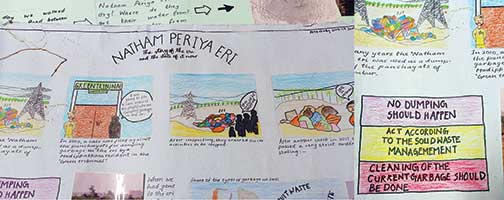
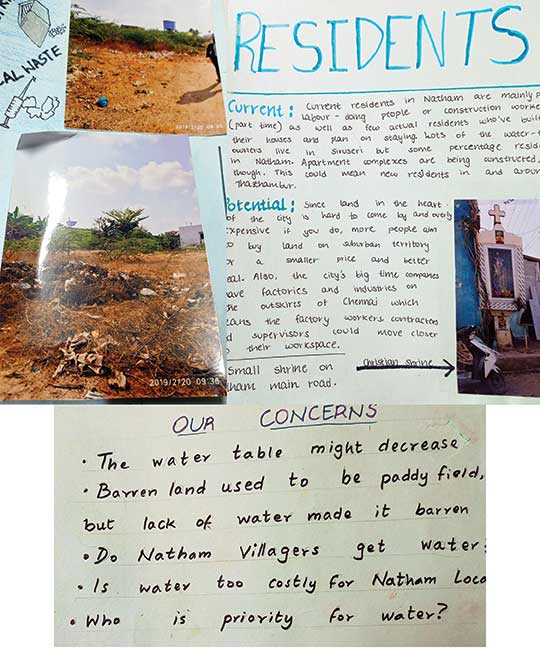
The fundamental effort of an Area Study is to enable children to learn directly ‘from’ the environment as opposed to merely learning ‘about’ it. Such contact-based, experiential approaches to multi-disciplinary learning offer a critical alternative to ‘content-heavy’ pedagogy which rarely goes beyond the classroom or the textbook. In this, students are able to see first-hand the stark contrast between the objectivity and certitude found in most textbooks, and the ambiguous and uneven ways in which social issues play out in the real world.
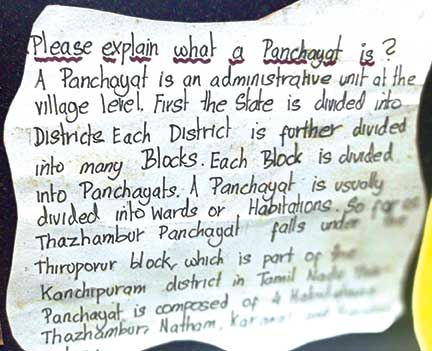
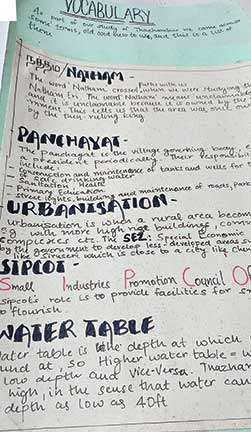
Importantly, just as much as the child, the teacher stands to benefit from such modes of learning. Working closely with other colleagues and with small groups of children, a teacher feels part of a larger ‘whole’, working towards a common vision, very different from the lonely, solo role she/he plays within the classroom. Interestingly, such Area Studies can offer a new lens through which a teacher can evaluate a child’s learning and potential too. Examining a child at close quarters – watching her/him interact with other individuals, take on responsibilities, find place within a group and contribute to a common goal, can offer a teacher fresh insight into a child’s strengths. None of this is possible in a standardized, text-based exam mode within the confines of the classroom. Finally, what makes an Area Study a wonderful platform for both teachers and children to come together is the fact that when the study commences, everyone is on a common ground of “not knowing”. This is quite unlike a regular classroom experience where the teacher is almost always in the know and has pre-decided what will be taught and perhaps learned. The unscripted learning opportunities which this offers allow for rigid roles to be broken down and fresh and collaborative relationships between the teacher-student and student-student to emerge, thus shaping a new classroom dynamic.
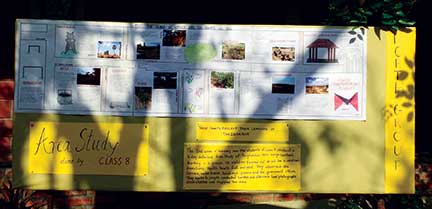
Ashwin Prabhu taught English and history at The School KFI for five years between 2014-19. The time he spent in school allowed him to examine his questions around learning, growing, and finding one’s place in the world, and his book “Classroom With A View – Notes from the Krishnamurti schools” published by Tara Books in 2022 is an outcome of that engagement. He can be reached at ashwin.prabhu@gmail.com.
Akhila Seshadri has been a teacher at The School KFI, Chennai for over 30 years. Her interests are: teaching-learning in history, English, and geography as well as music theatre and learning through field trips. She has written a few articles for The Journal of the Krishnamurti Schools, Teacher Plus and The Hindu. She is an avid cat lover! She can be reached at akhilaseshadri@gmail.com.
